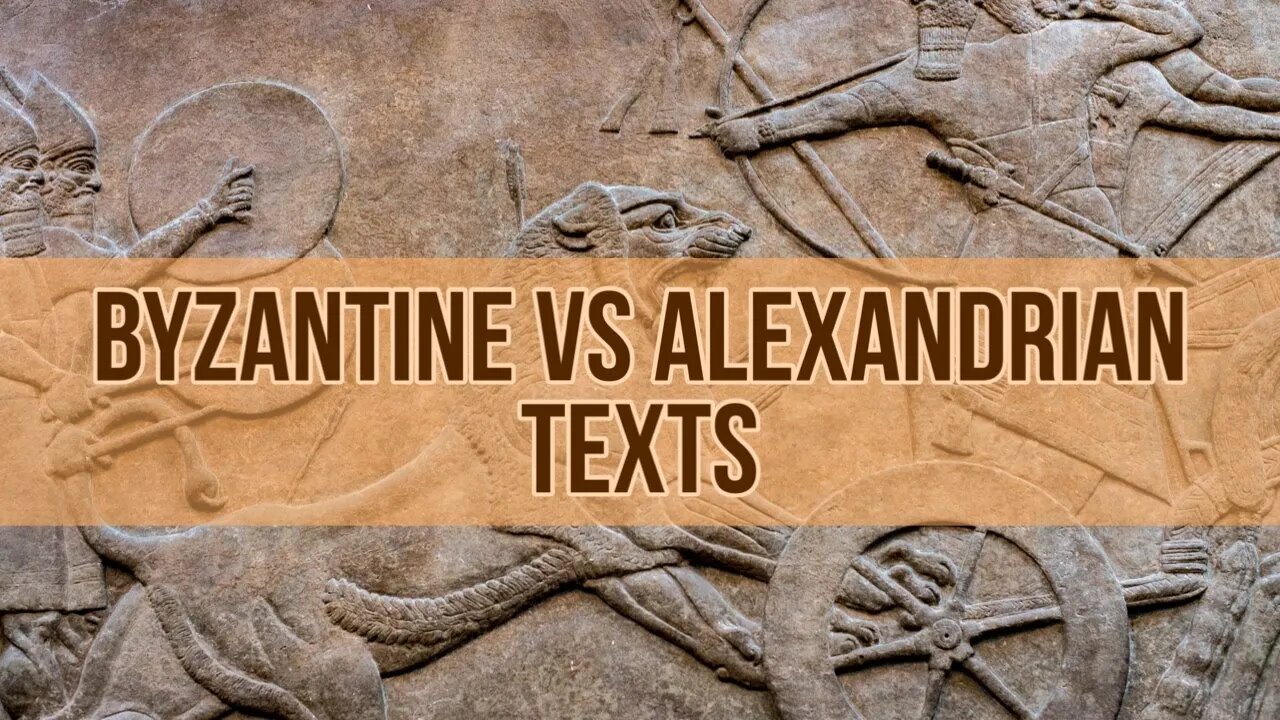Premium Only Content

History of the Bible- Part 2- Byzantine vs Alexandrian Text - Why the King James Bible only?
#byzantinevsalexandriantext #historyofthebible #whytheKingJamesBibleonly #isthebiblecorrupt
Welcome to This Week in the Word!
This is where I am sharing the work God is using to grow me. How I am preparing for his calling on my life, and being a witness to his glory. I am not a graduate of seminary, a theologian, or godly scholar. I am just a born again BIBLE believing disciple of Jesus.
My mission is to encourage people to seek God through reading his word.
This weeks study: Is the Bible Corrupt? Part 7- History of the New Testament Byzantine vs Alexandrian Text
Byzantine VS Alexandrian:
There are over 5800 copies of the greek new testament that have been found that were all written prior to the invention of the printing press. For this video to keep it super simple we are only going to focus on the two main lines.
History of The Byzantine Texts:
This family is named after the Byzantine Empire which was established as the eastern side of the Roman Empire after the Roman Empire split in the 200’s AD. These texts were found all throughout the eastern shores of the Mediterranean Sea. point of origin set in Antioch. This family of texts are dated to be written between mid-400’s AD up through the 15th century AD.
The Byzantine text are also known as the “majority text” because they make of the vast majority of the 5800 plus greek texts of the new testament. According to researcher Dean Burgon in his book The Traditional Text, 995 texts out of 1000 are from the Byzantine family. Hence the name “majority text”.
The Byzantine Texts are known for their detail. There is a lot more specific details about the life of Jesus in the Gospels, and even in some extra details in the epistles when compared to the AT.
The Byzantine Texts are known for their vast agreement, meaning they all say the same thing.
History of The Alexandrian Texts:
Said to have been written between the 2nd and 4th century AD in the region of Alexandria Egypt. There are far fewer text than the other families but the main work for English translations today is derived from 3 texts know as the Codex Alexandrinus, Codex Vaticanus and Codex Sinaiticus. (CA was written in Alexandria Egypt in late 300 AD by Thecla, a notable lady of Egypt, its first historical record is argued between 1308 AD and 1621 AD. The CV was discovered in 1761 by the Italian traveler Vitaliano Donati in the St. Catherine’s Monastery at Mt Sinai- Egypt when this traveler randomly came across it in the monastery library. CS was discovered in 1859 by Constantine von Tischendorf in St. Catherine’s Monastery at Mt Sinai- Egypt, in a garbage bin waiting to be burned by the monks. ). The method used to determine the date of origin is called paleography, which was invented by the catholic church, and isn’t very scientific. Essentially you look at the type of paper, the case set of the letters, sentence structor and the font.
The Alexandrian text is also known as the “critical text” for 2 reasons. First is because the lack of agreement between the different texts in this family. For example there are 3064 disagreements between Vaticanus and Sinaiticus just in the 4 gospels (Matthew, Mark, Luke and John). Second is because its readings are very abrupt using far fewer words.
This family of texts are known for omitting chunks of scripture, the biggest of which is Mark 16:9-20. Here is a list of the most common but this is far from an exhaustive list: Matthew 12:47; 16:2b–3; 17:21; 18:11; Mark 16:9-20; 9:44.46; 11:26; 15:28; Luke 17:36; John 5:4; 7:53-8:11; Acts 8:37; 15:34; 24:7; 28:29.
Follow us on Facebook: https://www.facebook.com/TinyLifeBigMission
Follow us on Instagram: https://www.instagram.com/tinylifebigmission
-
![What is the Trinity? Is the Trinity Biblical? [Close-handed doctrine 4: The Godhead]](https://1a-1791.com/video/s8/1/r/X/7/G/rX7Gl.0kob-small-What-is-the-Trinity-Is-the-.jpg) 39:53
39:53
Tiny Life Big Mission
1 year ago $0.02 earnedWhat is the Trinity? Is the Trinity Biblical? [Close-handed doctrine 4: The Godhead]
125 -
 2:23:02
2:23:02
Badlands Media
22 hours agoThe Liberty Den Ep. 133
87.9K37 -
 2:05:41
2:05:41
TimcastIRL
9 hours agoTrump SLAMS Ukraine President In TENSE WH Meeting, The War MAY END w/ Rob Smith | Timcast IRL
172K95 -
 10:31:05
10:31:05
Dr Disrespect
18 hours ago🔴LIVE - DR DISRESPECT - PGA TOUR 2K25 LAUNCH DAY
197K28 -
 2:30:04
2:30:04
Laura Loomer
9 hours agoEP105: MISSING: The Epstein Files
77.2K55 -
 1:46:14
1:46:14
Kim Iversen
10 hours agoTrump to Zelenskyy: 'You're Gambling with World War III'
86.3K132 -
 55:28
55:28
Glenn Greenwald
11 hours agoGlenn Reacts to Trump-Zelensky Exchange and Takes Q&A from our Members | SYSTEM UPDATE #415
134K235 -
 4:26:54
4:26:54
Nerdrotic
14 hours ago $38.63 earnedMarvel PANIC MODE! Kathleen Kennedy GONE?! Hollywood DEI Dead | Friday Night Tights 342 Nick Freitas
145K40 -
 1:30:03
1:30:03
Flyover Conservatives
1 day agoZelensky Fail... God Called IT!; From Prison to the White House: Angela Stanton King’s Unbelievable Redemption Story | FOC Show
58.7K6 -
 1:06:14
1:06:14
IsaacButterfield
13 hours ago $2.39 earnedFree Speech Is Dead | Did Trump Go Too Far? | Sexist Job
49.7K21